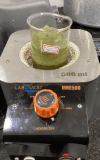Anti-inflammatory and Antioxidant Activity of Neem and Kirata-Induced Silver Nanoparticles Against Oral Biofilm: An In Vitro Study
- PMID: 39318902
- PMCID: PMC11420701
- DOI: 10.7759/cureus.67708
Anti-inflammatory and Antioxidant Activity of Neem and Kirata-Induced Silver Nanoparticles Against Oral Biofilm: An In Vitro Study
Abstract
Introduction Silver nanoparticles have been the most commonly used nanoparticles which could be integrated with plant extracts. The mutually beneficial interaction between neutral plant extracts and nanoparticles reduced the chemical toxicity while promoting synthesis. Azadirachta indica, widely known as the neem plant, has diverse medicinal compounds encompassing antibacterial, antiviral, antiprotozoal, insecticidal, antifungal, and antioxidant properties. Swertia chirata, known as Chirayata in India, stands out for its dual roles as a laxative and appetiser with pronounced antimicrobial and anti-inflammatory qualities. Hence, this study aimed to evaluate the anti-inflammatory and antioxidant properties of silver nanoparticles synthesized using Neem and Kirata extract. Materials and methods The plant extracts of Neem (Azadirachta indica) and Kirata (Swertia chirata) were obtained in powder form. It was later formulated into an extract and stored in a refrigerator at 4 degrees Celsius. The formulated extract of Neem and Kirata was then incorporated with silver nitrate to form a modified silver nanoparticle using a green synthesis approach. The anti-inflammatory activity of Neem and Kirata extract was tested using Bovine Serum Assay and Egg Albumin Assay. The antioxidant activity of the new herbal-formulated Ag nanoparticles was determined by the DPPH ((2,2-diphenyl-1-picrylhydrazyl) assay. Results Based on the anti-inflammatory assays, the Neem and Kirata-induced nanoparticles showed increasing levels of inhibition, while the standard showed slightly higher inhibition at 10, 20 and 30 µL. At 40 µL and 50 µL, both Kirata and Neem (Ag) and the standard showed high levels of inhibition, nearing 75% and above, with the standard consistently showing a marginally higher inhibition percentage. Based on the DPPH assay, the Neem Kirata-induced Ag nanoparticle showed a comparable or slightly higher inhibition percentage compared to the standard. Conclusion The study underscores the potential of Neem and Kirata herbal-based silver nanoparticles as effective anti-inflammatory and antioxidant agents. Future research directions should focus on refining nanoparticle synthesis, investigating mechanisms of action, and exploring additional therapeutic applications in the biomedical and pharmaceutical sectors.
Keywords: anti-inflammatory property; antioxidant property; biofilm; nanoparticles; neem and kirata.
Copyright © 2024, Raju et al.
Conflict of interest statement
Human subjects: All authors have confirmed that this study did not involve human participants or tissue. Animal subjects: All authors have confirmed that this study did not involve animal subjects or tissue. Conflicts of interest: In compliance with the ICMJE uniform disclosure form, all authors declare the following: Payment/services info: All authors have declared that no financial support was received from any organization for the submitted work. Financial relationships: All authors have declared that they have no financial relationships at present or within the previous three years with any organizations that might have an interest in the submitted work. Other relationships: All authors have declared that there are no other relationships or activities that could appear to have influenced the submitted work.
Figures





References
-
- Inamuddin Inamuddin, Boddula R, Asiri AM. Scrivener Publishing LLC; [ Apr; 2024 ]. 2020. Actuators: Fundamentals, Principles, Materials and Applications.
-
- Nanotechnology and dentistry. Ozak ST, Ozkan P. https://pubmed.ncbi.nlm.nih.gov/23408486/ Eur J Dent. 2013;7:145–151. - PMC - PubMed
-
- Green synthesis of nanoparticles: current developments and limitations. Ying S, Guan Z, Ofoegbu PC, Clubb P, Rico C, He F, Hong J. Environ Technol Innov. 2022;26:102336.
-
- Mérillon JM, Riviere C. Natural Antimicrobial Agents. Sustainable Development and Biodiversity. Springer International Publishing; 2018. Natural Antimicrobial Agents. Sustainable Development and Biodiversity.
-
- Medicinal properties of neem leaves: a review. Subapriya R, Nagini S. Curr Med Chem Anticancer Agents. 2005;5:149–156. - PubMed
LinkOut - more resources
Full Text Sources
